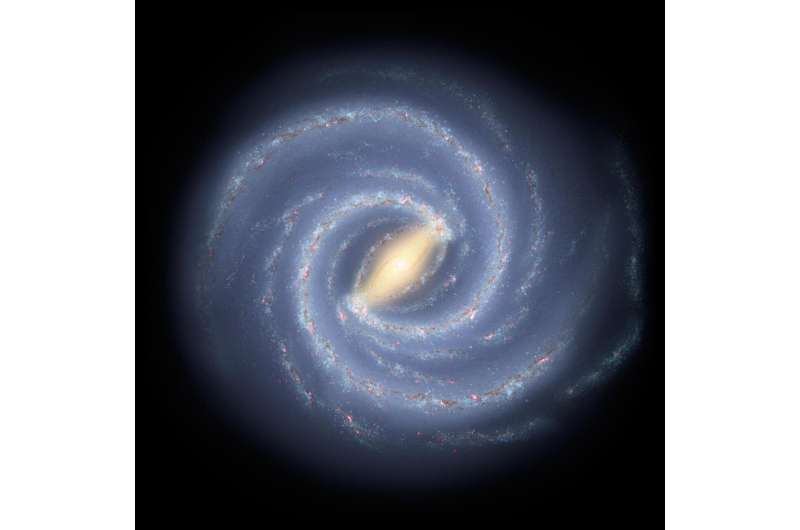
Astrophysicists say they have found an answer to why spiral galaxies like our own Milky Way are largely missing from a part of our local universe called the Supergalactic Plane.
The Supergalactic Plane is an enormous, flattened structure extending nearly a billion light years across in which our own Milky Way galaxy is embedded.
While the Plane is teeming with bright elliptical galaxies, bright disk galaxies with spiral arms are conspicuously scarce.
Now an international team of researchers, co-led by Durham University, UK, and the University of Helsinki, Finland, say different distributions of elliptical and disk galaxies arise naturally due to the contrasting environments found inside and outside the Plane.
In the dense galaxy clusters found on the Supergalactic Plane, galaxies experience frequent interactions and mergers with other galaxies. This transforms spiral galaxies into elliptical galaxies—smooth galaxies with no apparent internal structure or spiral arms—and leads to the growth of supermassive black holes.
By contrast, away from the Plane, galaxies can evolve in relative isolation, which helps them preserve their spiral structure.
The findings are published in the journal Nature Astronomy.

The Milky Way is part of the Supergalactic Plane, which contains several massive galaxy clusters and thousands of individual galaxies. The vast majority of galaxies found here are elliptical galaxies.
The research team used the SIBELIUS (simulations beyond the local universe) supercomputer simulation, which follows the evolution of the universe over 13.8 billion years from the early universe to the present day.
While most cosmological simulations consider random patches of the universe, which cannot be directly compared to observations, SIBELIUS aims to precisely reproduce the observed structures, including the Supergalactic Plane. The final simulation is remarkably consistent with observations of our universe through telescopes.
Research co-author Professor Carlos Frenk, Ogden Professor of Fundamental Physics, in the Institute for Computational Cosmology, Durham University, said, “The distribution of galaxies in the Supergalactic Plane is indeed remarkable.
“It is rare but not a complete anomaly: our simulation reveals the intimate details of the formation of galaxies such as the transformation of spirals into ellipticals through galaxy mergers.
“Further, the simulation shows that our standard model of the universe, based on the idea that most of its mass is cold dark matter, can reproduce the most remarkable structures in the universe, including the spectacular structure of which the Milky Way is part.”

The peculiar separation of spiral and elliptical galaxies in the local universe, which has been known about since the 1960s, features prominently in a recent list of “cosmic anomalies” compiled by renowned cosmologist and 2019 Nobel laureate Professor Jim Peebles.
Research lead author Dr. Till Sawala, a postdoctoral researcher at Durham University and at the University of Helsinki, said, “By chance, I was invited to a symposium in honor of Jim Peebles last December at Durham, where he presented the problem in his lecture.
“And I realized that we had already completed a simulation that might contain the answer. Our research shows that the known mechanisms of galaxy evolution also work in this unique cosmic environment.”
The supercomputer simulations were performed on the Cosmology Machine (COSMA 8) supercomputer, hosted by the Institute for Computational Cosmology at Durham University on behalf of the UK’s DiRAC High-Performance Computing facility and on CSC’s Mahti supercomputer in Finland.
More information:
Distinct distributions of elliptical and disk galaxies across the Local Supercluster as a ΛCDM prediction, Nature Astronomy (2023). DOI: 10.1038/s41550-023-02130-6
Provided by
Durham University
Citation:
Physicists answer question of Supergalactic Plane’s absent spiral galaxies (2023, November 20)
retrieved 20 November 2023
from https://phys.org/news/2023-11-physicists-supergalactic-plane-absent-spiral.html
This document is subject to copyright. Apart from any fair dealing for the purpose of private study or research, no
part may be reproduced without the written permission. The content is provided for information purposes only.
